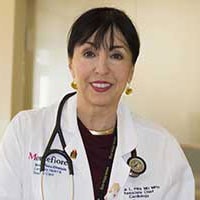This transcript has been edited for clarity.
Ileana L. Piña, MD, MPH: Hello. I'm Ileana Piña from Thomas Jefferson University. I'm here in Chicago at the sessions of the American Heart Association. This is our first real live session even though there's a virtual component, which then brings me to my guest, Dr Alex Mebazaa.
I've known Alex now for several years — we won't say how many — and we have been working across the pond with very similar ideas about what to do when the patients are in the hospital with acute decompensated heart failure (ADHF) — we even have a paper about that — and then what happens when that patient leaves the hospital. In the United States, we don't do a great job on that transition of care.
Alex has been thinking about this, as many of us have. Alex, introduce yourself and then we'll get right into your study.
Alexandre Mebazaa, MD, PhD: I confirm that I've known Professor Piña for a few years; I won't say how many. I am a professor of intensive care in University of Paris.
STRONG HF Trial
Piña: I've been hearing about your STRONG-HF study, and it's something that you thought extensively about in how you constructed it. Tell our audience what the study has been now that it's complete and has data.
Mebazaa: The initial idea is exactly like you said. I think you, me, and others were really sad to see patients coming back again and again for ADHF, and when you open the chart, you see that they're not fully treated.
I think for us specialists, we clearly see the relationship between the fact that they're not well treated and the fact that they're coming again and again. If someone has cancer and goes to the oncologist on Friday, the oncologist says to come Wednesday for a full dose of chemotherapy, they give you a card in case you have a side effect, and they take care of the patient. I wondered why for heart failure we don't have the same idea.
Piña: The concept is very similar, actually.
Mebazaa: Chemotherapy has side effects like beta-blockers or other medicines. We designed the study like this. We also learned from GUIDE-IT.
Piña: I'm glad we taught you something.
Mebazaa: One of the issues in GUIDE-IT is that the two arms were run in parallel by the same investigators, and it's really difficult for an investigator to do one thing to one patient and then do a different thing to another patient the same day. This is why the usual care group in STRONG-HF really received the usual care that we were doing before. For a patient with acute heart failure, before being discharged, you write a report, you send it to the cardiologist, and the patient is followed by the cardiologist.
In the high-intensity care arm, before being discharged, patients were given half of the optimal dose of three classes of drug, renin-angiotensin system (RAS) inhibitor, beta-blocker, and spironolactone. Really, combining the three at half of the dose. Then, we were seeing the patients 3 weeks in a row.
Piña: Once they go home, when is the first outpatient visit?
Mebazaa: If, for example, the patient is leaving on Wednesday, it's really easy. The nurse would ask them to come back to our outpatient center next Wednesday. At the 1-week visit, we check that the three drugs given in combination at the half dose were safe.
Piña: That the patient is okay.
Key Physical Exam and Labs
Mebazaa: Okay is not shaking hands. We put a procedure in place that needs to be followed. This procedure is combining one clinical exam (heart rate, blood pressure, edema) and biologic exam with four components. (N-terminal pro-B-type natriuretic peptide [NT-proBNP], potassium, creatinine, and hemoglobin). In fact, the way we design it is more or less easy. They come to the outpatient center early in the morning and we draw the blood, we go to the lab, the results come, and then the patient enters.
Piña: The patient is seen with the labs already in hand.
Mebazaa: Exactly. At week 1, we check that everything is fine. Then we say, "Okay, we hope to see you next Wednesday." Next Wednesday is the important week 2 visit where we are going to go from half doses of three drugs to full doses of the three drugs.
We decide if we are going to give the green light for those three drugs by looking at all the parameters we measured. If, for instance, everything is fine, then we go to full dose, we check safety at week 3, and then we see the patient back only at week 6 and 90 days.
If one of the parameters is not okay, let's say heart rate is down, then no problem. We may increase the two other drugs and leave that one as is. Then at week 3, we will check. Maybe the heart rate has increased or maybe it will stay low, which means that the patient needs only half dose. Really, the procedure is rather easy.
Another question that is often asked is what happens if after half the dose of beta-blocker, NT-proBNP goes up? It's easy. We told the investigators to give diuretics for 1 week and wait for the NT-proBNP to fall.
Piña: You're treating that NT-proBNP as volume.
Mebazaa: Yes. As a mark of congestion. In fact, in GUIDE-IT, NT-proBNP was used as a target of therapies. Here, we are using NT-proBNP as a security net. NT-proBNP, when you're discharged from hospital, should only go down. If NT-proBNP stays stable or increases, that is a clearly red signal. Then, we don't change the drug, keep the patient on the half dose of the beta-blocker, and give diuretics for 1 week.
Piña: Does the patient get examined at that visit?
Mebazaa: Yes. At every visit, we have exactly the same procedure. It's easy.
Where Might SGLT2 Inhibitors and Advanced Practitioners Fit
Piña: When does the Sodium-Glucose Cotransporter 2 (SGLT2) inhibitor come in?
Mebazaa: It's a very good question. When we started the study 5 years ago, the SGLT2 inhibitors were not recommended. We did an amendment to the protocol 2 years ago, where we said that two agents should be given on the basis of the local habits and recommendations. One is SGLT2 inhibitors.
Piña: They can add it in anytime?
Mebazaa: Whenever they want. The second agent is iron supplementation.
Piña: What was your endpoint?
Mebazaa: The endpoint was 180-day heart failure readmission or death.
Piña: Time to first event.
Mebazaa: Then the data and safety monitoring board (DSMB) called to say we have two issues. One, for the primary endpoint, the difference between the two arms is exceeding what was expected.
Piña: This was even going through COVID-19.
Mebazaa: In The Lancet paper, you will see that if you remove the patients who died from COVID-19, the benefit is even larger. Another thing they said that is really very interesting, I think, as a trialist, is that it's unethical to keep patients in the usual care group.
Piña: That's a big statement.
Mebazaa: Exactly. It's a big statement because, in fact, usual care is what patients all around the world get. It's as if the DSMB wrote a letter that could be in The New York Times saying how we treat heart failure patients around the world is unethical.
Piña: What do you do in Paris, does it have to be a cardiologist? Does it have to be a heart failure person who does this in the community?
Mebazaa: I think that's a very good question. The first comment is, Alex, how are we going to have a cardiologist, and maybe even the same cardiologist, doing four visits, three in a row and then the visit at week 6?
How many times do you see a chronic heart failure patient over a year? Maybe three or four times?
Piña: I see them more often than that.
Mebazaa: Let's say three or four times. What I'm saying is those three or four times, you're giving them some dates to return but without knowing exactly why you chose 6 months or 3 months or 4 months? Well, why don't we concentrate this after discharge from a heart failure hospitalization. When a patient is hospitalized for decompensated heart failure, this means that in the years before, we didn't do a good job.
Piña: Something went wrong.
Mebazaa: Exactly. Let's use this acute decompensated hospitalization like the beginning of a second life. Instead of having maybe several appointments, let's put three together and we optimize. It means that the patients with heart failure need to be seen differently.
The next point is should we have a cardiologist for all the exams? For the protocol, we needed to have a heart failure specialist to really prove the point.
Piña: To do the trial, you needed to do that.
Mebazaa: However, I think everybody would agree that visits one and three can be done by nurses or remotely.
Piña: Or pharmacists in the United States.
Mebazaa: Visit two is the most important.
Piña: That's the biggie. That's where you're making decisions.
Mebazaa: Exactly. In The Lancet paper, we explained a few tricks.
There is one point I would like to mention, which is the ejection fraction. As you all know, and we've published this so much all around the world, acute heart failure is half reduced ejection fraction and half heart failure with preserved ejection fraction (HFpEF). When we included those patients, the results were as good.
Piña: You didn't make any difference between ejection fractions.
Mebazaa: The results were positive in both groups, and this is very helpful. When we designed, the steering committee was really very helpful. I used to say we had a really STRONG-HF dream team and all of them are co-authors of the paper.
Piña: I congratulate you, wonderfully. I want to thank you for taking the time. I know this is a busy meeting. I want to thank Dr Mebazaa for joining me today, and I urge all of you to take a look at the paper.
More importantly, I urge you to not wait 3 weeks to see a patient when you send them home. We should be seeing them within the first 2 weeks because bad things happen, and they happen very quickly. That 30-day readmission rate isn't really 30. It's more like 2 weeks when they start to decompensate and get bad again.
Get your patients back in again, even if you do a brief visit, see how they're doing, get the drugs on board before they walk out the door, and then keep up titrating. Remember that I always say in heart failure, stability is an illusion. There's no such thing.
Have a great day. Thank you for joining me.
Ileana L. Piña, MD, MPH, is a heart failure and cardiac transplantation expert. She serves as an advisor/consultant to the US Food and Drug Administration's Center for Devices and Radiological Health and has been a volunteer for the American Heart Association since 1982. Originally from Havana, Cuba, she is passionate about enrolling more women and minorities in clinical trials. She also enjoys cooking and taking spin classes.
Follow theheart.org | Medscape Cardiology on Twitter
Follow Medscape on Facebook, Twitter, Instagram, and YouTube
© 2022 WebMD, LLC
Any views expressed above are the author's own and do not necessarily reflect the views of WebMD or Medscape.
Cite this: Ileana L. Piña, Alexandre Mebazaa. STRONG-HF Strategy for Intense ADHF Discharge Care Explained - Medscape - Nov 14, 2022.












Comments